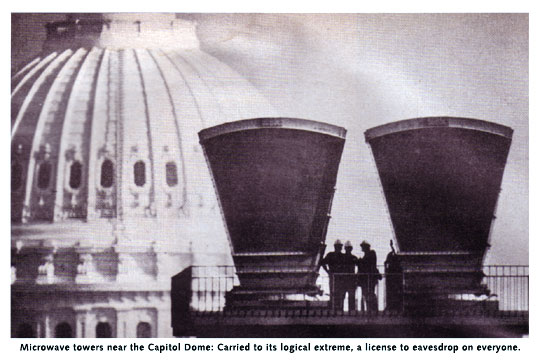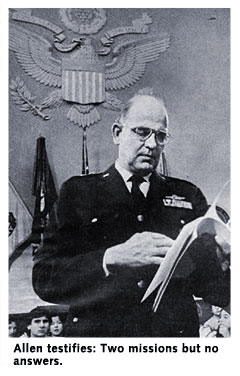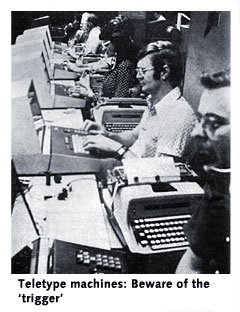No Place to Hide
Russell Watson with Evert Clark and Anthony Marro in Washington - Newsweek September 8, 1975
When the Rockefeller commission reported on CIA surveillance activities last spring, it also warned that "Communist countries" could be eavesdropping on Americans. The report left a lot unsaid, but it touched off new speculation that the U.S. Government might be up to the same sort of tricks. In an interview last month, Idaho's Frank Church, chairman of the Senate committee that also is investigating the CIA, issued an oblique but impassioned warning that the technology of eavesdropping had become so highly developed that Americans might soon be left with "no place to hide." That day may have arrived. NEWSWEEK has learned that the country's most secret intelligence operation, the National Security Agency, already possesses the computerized equipment to monitor nearly all overseas telephone calls and most domestic and international printed messages-and that the NSA has made heavy use of its Orwellian technology.
|

|
 The agency's devices monitor thousands of telephone circuits, cable lines and the microwave transmissions that carry an increasing share of both spoken and written communications. Computers are programmed to watch for "trigger" words or phrases indicating that a message might interest intelligence analysts. When the trigger is pulled, entire messages are tape-recorded or printed out. NSA is essentially a military organization, and Defense Department officials deny that civilians are monitored on any vast scale. But NEWSWEEK's intelligence sources insist that the agency regularly scans most if not all overseas cables and telephone traffic and a large volume of written domestic communications. Some of the intercepted messages, moreover, have dealt with such civilian concerns as antiwar activism and, reportedly, grain sales to Russia.
Intelligence committees in both the Senate and the House of Representatives have begun to learn about these activities only recently, and the eavesdropping issue will be a potentially explosive feature of their hearings this fall. There are indications that the NSA has begun to cut back on the monitoring program, perhaps because of the attention it has attracted. It is by no means clear, however, that the agency has done anything illegal, if only because technology has far outrun the law; eavesdropping can now be accomplished in ways not anticipated by even the latest anti-wiretapping legislation. Most activities of the monitoring program, moreover, have had a legitimate national-security motive-as well as the impetus that comes from knowing that the Russians do it too-in the U.S.

Secretive: The NSA is so secretive that it almost makes the CIA look like an open book. Even its "charter"-National Security Council Intelligence Directive No. 6-is classified as supersecret. So are most of its other vital statistics, but informed estimates place the agency's annual budget at roughly $1.2 billion (nearly twice the CIA's) and its domestic staff at 20,000 people, plus thousands of military personnel at 2,000 monitoring stations around the world. Headquartered at Fort Meade, Md., the agency has always been led by a military man, and last month, for the first time in the NSA's 23-year history, its director, Air Force Lt. Gen. Lew Allen Jr., 49, testified in public before a Congressional committee.
Allen was not very informative. When Rep. Otis Pike of New York asked for a simple "yes" or "no" to the question of whether the agency was intercepting overseas telephone calls placed by Americans, Allen said the law forbade an answer. The general did expand, however, on the NSA's two missions: "One is that of protecting U.S. communications from foreign intelligence exploitation-this is our communications security [COMSEC] mission. Our other mission is to exploit foreign communications in order to provide information to our own government-this is called our signals intelligence [SIGINT] mission."
Intercept: In simple language, the agency's job boils down to intercepting messages and breaking codes. To do that, the NSA's engineers have revolutionized the art of eavesdropping, and their job has been made easier by the fact that almost all long-distance transmissions of telephone and teletype messages in the U.S. are now carried by microwave, a high-frequency radio signal that bounces between towers spaced up to 50 miles apart. Microwave transmissions are far easier to intercept than messages carried on conventional land-lines-a fact that is only slowly dawning on government officials who regularly send and receive secret information.
 The NSA's listening devices-and similar ones developed by the Soviets-can tune in on electronic pulses from microwave transmissions or, less readily, land-lines. The messages are scanned constantly. An interception occurs only when the computers detect a "trigger" word or phrase indicating that the message might be of interest to intelligence or law-enforcement officials-"agent," for example, or "heroin." Instantly, the entire message is recorded or printed out; depending on its content and importance, it may end up in the Pentagon or the White House.
The NSA's listening devices-and similar ones developed by the Soviets-can tune in on electronic pulses from microwave transmissions or, less readily, land-lines. The messages are scanned constantly. An interception occurs only when the computers detect a "trigger" word or phrase indicating that the message might be of interest to intelligence or law-enforcement officials-"agent," for example, or "heroin." Instantly, the entire message is recorded or printed out; depending on its content and importance, it may end up in the Pentagon or the White House.
The prime targets of the monitoring are Soviet-bloc diplomats, military officers and espionage agents in the U.S. But almost any communication may be of value to Washington's intelligence analysts. The NSA apparently is interested in data transmitted by multinational corporations, especially oil companies and arms suppliers. Intelligence sources also assume that the NSA monitors news organizations overseas at least occasionally; one reason is that when covering sensitive stories or fast-breaking events, they may have more up-to-date information than government agencies. "Never send the name of a secret source over the air," cautions one official. "They'll get it."
Often, intercepted messages deal only indirectly, if at all, with national security. It is clear from the Rockefeller commission report that for a time the NSA monitored all telephone calls between the U.S. and Latin America as part of President Nixon's war on narcotics smuggling. One of NEWSWEEK's intelligence sources believes that the NSA has monitored all communications traffic having to do with the sales of grain to the Soviet Union. The agency also played a role in Operation Chaos, the surveillance of antiwar activists between 1967 and 1974. Government officials have identified the NSA as the source of 1,100 pages of material given to the CIA on antiwar activities and foreign-travel plans by U.S. dissidents. Indeed, some defenders of the NSA complain that it is too often burdened with work that has nothing to do with catching Russian spies or cracking codes.
One of the thorniest questions facing the NSA is where to draw the line on its communications monitoring. "If you can afford to have this capability-and so far this country has been able to afford it-then there is no sector of signal communications that you can avoid, because any of them could mask illegal activity." Says a counterintelligence veteran who has used the NSA's output. If any sort of communication was declared off-limits, this reasoning goes, enemy agents would begin trying to transmit their messages on that particular channel. Carried to its logical extreme, however, that is a license to eavesdrop on everyone.
So far, Federal law does not specifically prohibit the NSA's brand of surveillance. Direct tampering with "wire, cable or the like connection" is illegal. But no one at the NSA has to shinny up a telephone pole and clamp alligator clips onto a terminal box. Instead, the agency plucks electronic pulses out of thin air, and current laws make no mention of the "carrier frequencies" employed by microwave. Thus, the monitoring done by the NSA appears to be perfectly legal, although some courts are beginning to examine that interpretation in cases challenging current wiretap laws.
'Scrambler': In any case, NSA's domestic monitoring activities are paralleled by the eavesdropping of the Soviet Union. To tap electronic transmissions in the U.S., the Russians have set up at least five listening posts across the country, including one at their embassy in Washington and other at Soviet offices in New York and San Francisco. Rooftop antennas enable them to intercept messages carried by microwave-including, apparently, long-distance telephone calls by U.S. officials. Secure "scrambler" telephones are available, but according to one intelligence expert, "about 90 percent of the business of government in Washington is done on open phones." According to this source, many government officials do not yet fully appreciate the danger.
The Soviets also have upgraded their spying on military installations in the U.S. Their agents have reportedly managed to bury automated electronic snoopers on mountaintops and desert flatlands near key bases, including the Strategic Air Command headquarters in Omaha, Neb. (Russian diplomats can't travel to sensitive areas, but their surrogates, including diplomats from Soviet-bloc countries, can and do.) The buried units are designed to pop up an antenna from underground to record U.S. military transmissions. When an orbiting Soviet satellite passes overhead, the robot antenna pops up again and transmits the data it has collected.
That kind of eavesdropping may sound like science fiction, but it is mere nuts and bolts compared with breakthroughs that lie ahead in the field of snoopery. Already it is technically feasible to "bug" an electric typewriter by picking up its feeble electronic emissions from a remote location and then translating them into words. And some scientists believe that it may be possible in the future for remote electronic equipment to intercept and "read" human brain waves.
The present and future state of the eavesdropping art gets civil libertarians into a cold sweat. On NBC's "Meet the Press" last month, Frank Church warned that bugging technology "at any time could be turned around on the American people, and no American would have any privacy left, such is the capability to monitor everything-telephone conversations, telegrams, it doesn't matter � I know the capacity that is there to make tyranny total in America."
Coups: The NSA intends nothing like tyranny-it is probably the most apolitical agency in Washington. "These people are about as selfless as any group I've ever known," says one sympathetic official, and all the available evidence supports that view. The agency appears to have been involved to some degree-"dragged in by the scruff of the neck," one high-ranking intelligence source puts it-into Richard Nixon's short-lived "Huston Plan", for domestic surveillance. Some of the illegal break-ins envisaged under the plan, according to the then White House aide, Tom Charles Huston, who devised it, were necessary to obtain foreign cryptographic material for the NSA. Huston later told a House committee that the NSA had pushed hard for approval of those parts of the plan covering intelligence-gathering break-ins, which in the past had led to some major code-cracking coups.
But the central issue raised by NSA's huge eavesdropping network is not really whether the agency has over stepped its authority. The point is that the scientific capability for this wholesale monitoring now exists, and where the capability exists, so too does the potential for abuse. It is the old story of technology rushing forward with some new wonder, before the men who supposedly control the machines have figured out how to prevent the machines from controlling them.
|




 The NSA's listening devices-and similar ones developed by the Soviets-can tune in on electronic pulses from microwave transmissions or, less readily, land-lines. The messages are scanned constantly. An interception occurs only when the computers detect a "trigger" word or phrase indicating that the message might be of interest to intelligence or law-enforcement officials-"agent," for example, or "heroin." Instantly, the entire message is recorded or printed out; depending on its content and importance, it may end up in the Pentagon or the White House.
The NSA's listening devices-and similar ones developed by the Soviets-can tune in on electronic pulses from microwave transmissions or, less readily, land-lines. The messages are scanned constantly. An interception occurs only when the computers detect a "trigger" word or phrase indicating that the message might be of interest to intelligence or law-enforcement officials-"agent," for example, or "heroin." Instantly, the entire message is recorded or printed out; depending on its content and importance, it may end up in the Pentagon or the White House.
